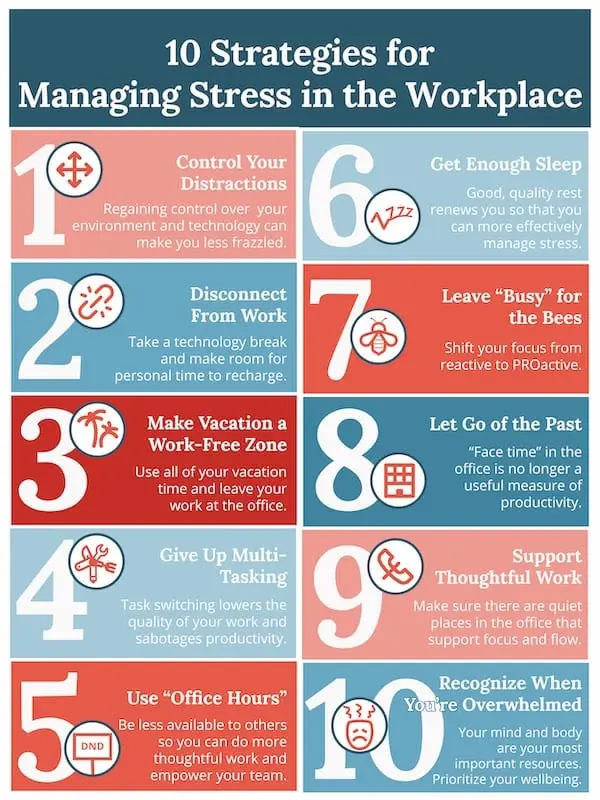What are the most effective methods for managing and reducing workplace distractions?


In today’s fast-paced work environment, distractions can be a major hindrance to productivity. From constant email notifications to chatty coworkers, there are countless factors that can divert our attention away from the task at hand. However, by implementing effective methods for managing and reducing workplace distractions, individuals can regain control of their focus and improve their overall productivity. In this article, we will explore some of the most effective strategies for managing and reducing workplace distractions, including productivity tips, time management strategies, concentration techniques, and work environment optimization.
Productivity Tips
1. Prioritize tasks: Start each day by identifying the most important tasks that need to be accomplished. By focusing on these high-priority tasks first, you can ensure that they are completed before any potential distractions arise.
2. Set clear goals: Clearly define your goals for the day, week, or month. Having a clear vision of what needs to be accomplished can help you stay focused and motivated, reducing the likelihood of succumbing to distractions.
3. Break tasks into smaller chunks: Large tasks can be overwhelming and lead to procrastination. Break them down into smaller, more manageable tasks. This not only makes them less daunting but also allows for a sense of accomplishment as each smaller task is completed.
4. Use productivity tools: There are numerous productivity tools available that can help manage distractions and improve focus. These tools can block certain websites or apps, limit social media usage, or provide reminders and timers to keep you on track.
Time Management Strategies
1. Time blocking: Allocate specific time blocks for different tasks or activities throughout the day. By dedicating uninterrupted time to specific tasks, you can minimize distractions and increase productivity.
2. Pomodoro Technique: This technique involves working in short bursts of focused activity, typically 25 minutes, followed by a short break. After a few cycles, take a longer break. This method helps maintain focus and prevents burnout.
3. Avoid multitasking: Contrary to popular belief, multitasking can actually decrease productivity. Instead, focus on one task at a time, completing it before moving on to the next. This allows for better concentration and reduces the likelihood of distractions.
4. Delegate tasks: If possible, delegate tasks that can be handled by others. This frees up your time to focus on more important or complex tasks, reducing the chances of being distracted by less critical responsibilities.
Concentration Techniques
1. Mindfulness meditation: Practicing mindfulness meditation can improve focus and attention span. By training your mind to stay present and aware, you can better resist distractions and maintain concentration on the task at hand.
2. Deep work: Deep work refers to a state of focused, uninterrupted work on a single task. Create a dedicated space and time for deep work, free from distractions such as phone calls or emails. This allows for maximum concentration and productivity.
3. Visualization techniques: Before starting a task, visualize yourself successfully completing it. This mental preparation can help improve focus and motivation, making it easier to resist distractions.
Work Environment Optimization
1. Minimize noise: Excessive noise can be a major distraction in the workplace. Consider using noise-canceling headphones or playing background music to drown out distractions and create a more focused environment.
2. Create a designated workspace: Designate a specific area for work that is free from distractions. This could be a separate room, a quiet corner, or even a specific desk arrangement. Having a dedicated workspace helps signal to your brain that it’s time to focus.
3. Establish boundaries: Communicate with coworkers and set boundaries to minimize interruptions. Let them know when you need uninterrupted time and establish protocols for urgent matters that require immediate attention.
4. Manage digital distractions: Turn off unnecessary notifications on your devices and limit your access to social media during work hours. Consider using website blockers or apps that track and limit your time spent on distracting websites or apps.
By implementing these methods for managing and reducing workplace distractions, individuals can significantly improve their focus, productivity, and overall work performance. Remember, it’s important to find the strategies that work best for you and adapt them to your specific work environment. With practice and consistency, you can regain control of your attention and achieve greater success in your professional endeavors.
Recent Posts
How do I create an engaging and informative online quiz or assessment?
Creating an engaging and informative online quiz or assessment can be a powerful tool for… Read More
What are the most effective methods for managing and reducing work-related stress in the hospitality industry?
Work-related stress is a common issue in the hospitality industry, where employees often face long… Read More
How can I improve my assertiveness and communication skills in a leadership position?
In a leadership position, assertiveness and effective communication skills are crucial for success. Being able… Read More
What are the key elements of a successful employee recognition and rewards program?
Employee recognition and rewards programs play a crucial role in motivating and engaging employees, as… Read More
How do I effectively manage and respond to customer feedback and reviews?
Customer feedback and online reviews play a crucial role in shaping a company's reputation and… Read More
What are the best strategies for effective time management as a stay-at-home parent?
Effective time management is crucial for stay-at-home parents who juggle multiple responsibilities on a daily… Read More